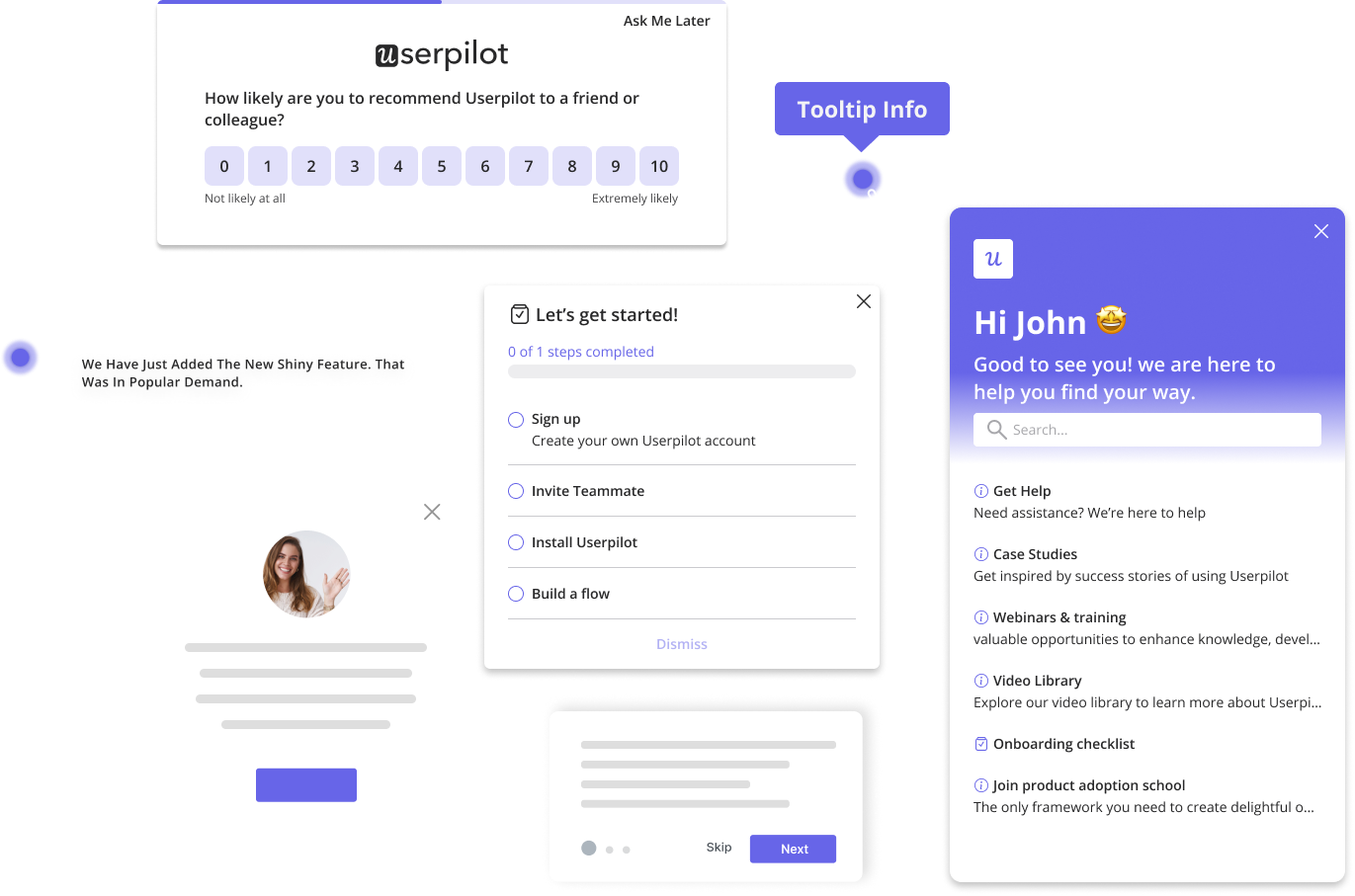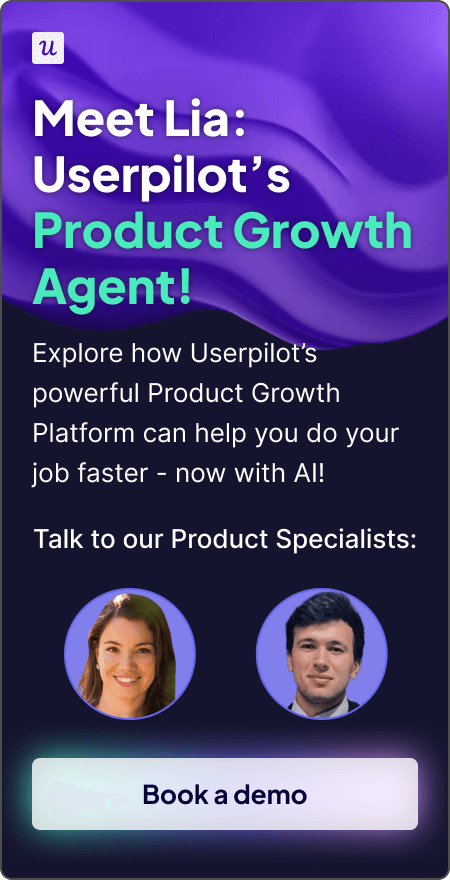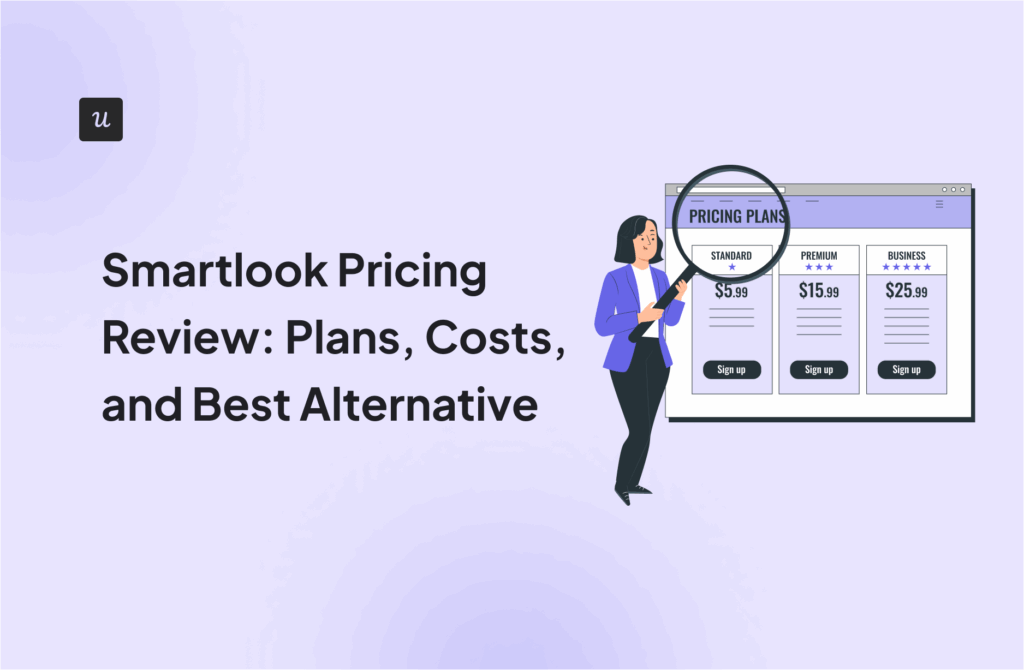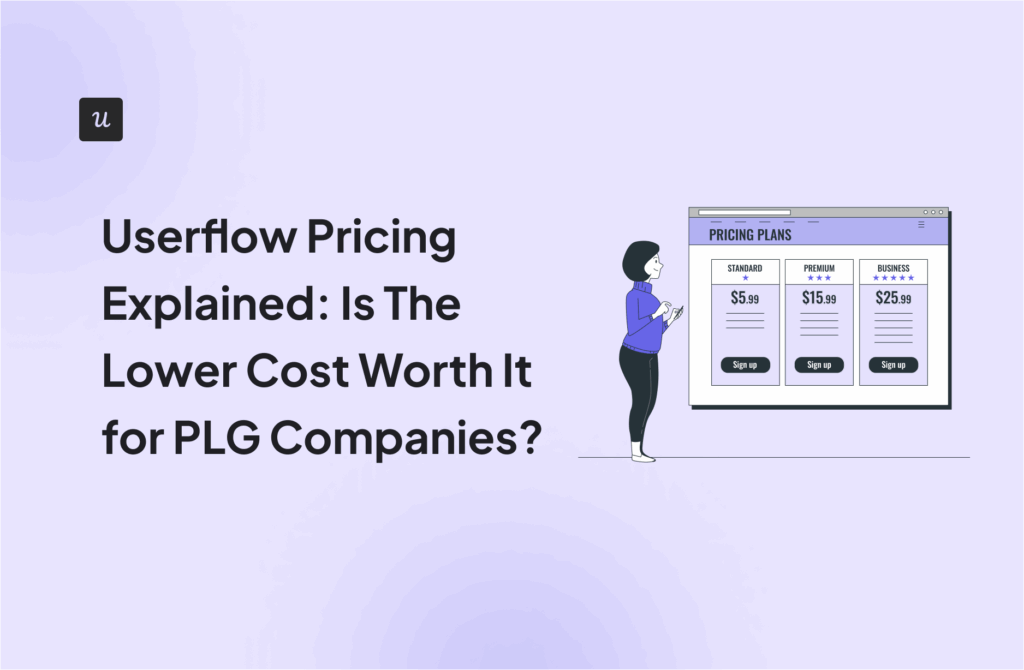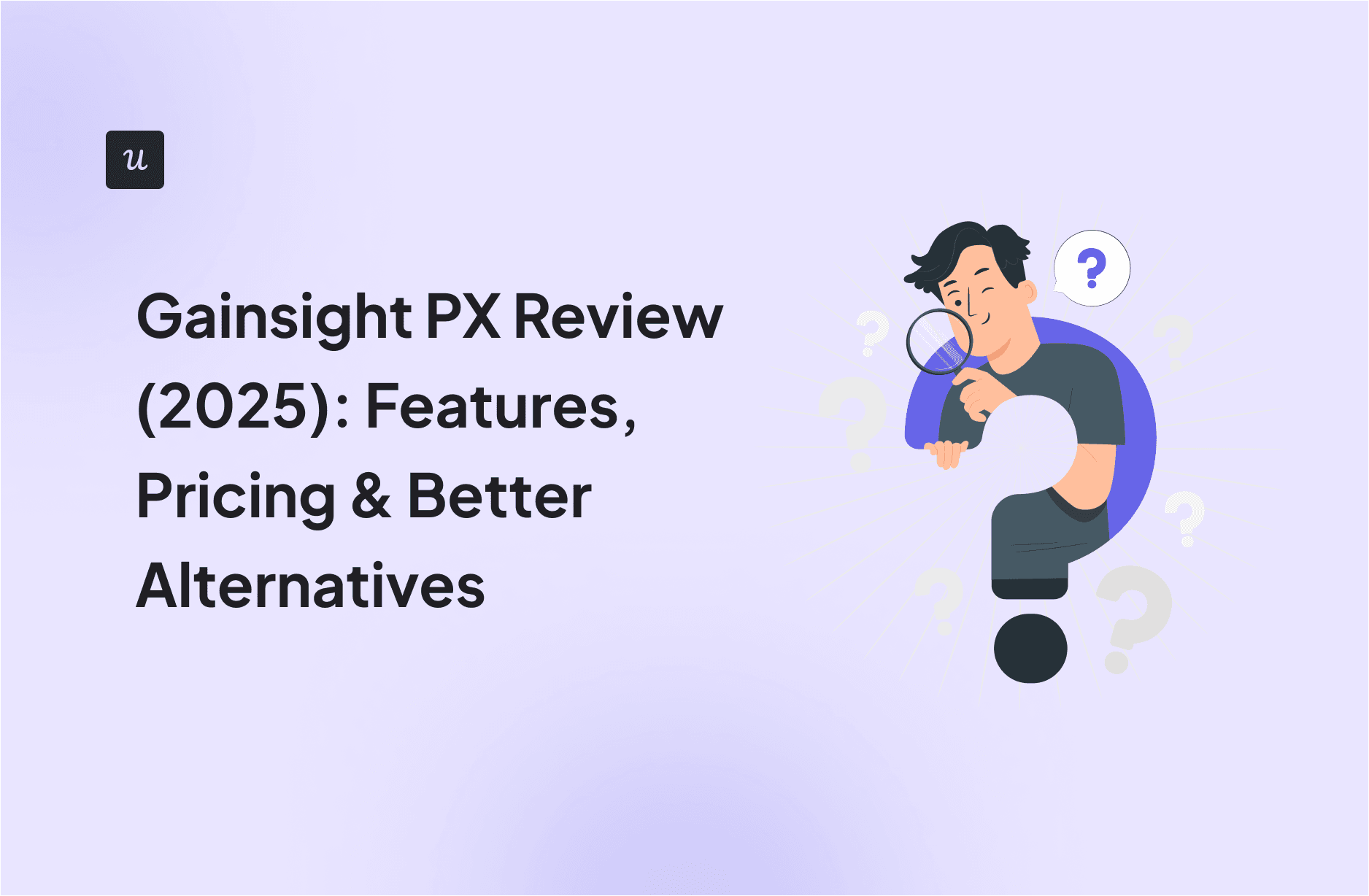
Choosing the right product experience platform is critical for your user onboarding strategy, but with enterprise-level pricing and a notoriously steep learning curve, is Gainsight PX the right investment for your business?
Gainsight PX has established itself as a comprehensive product experience solution, offering powerful analytics, in-app engagement tools, and feedback collection capabilities. The reality most review sites gloss over: pricing and maintenance.
In this review, we’ll give you the unfiltered facts. Whether you’re a startup weighing your options, a mid-sized company looking to scale, or an enterprise evaluating platforms, you need transparent information about what Gainsight PX actually delivers.
How quickly do you need to launch and test in-app experiences?
What’s your biggest hurdle with complex platforms like Gainsight PX?
What’s your primary goal for a product experience platform?
Stop wrestling with the complexity of Gainsight PX.
You need a fast, flexible, and no-code solution to drive product growth.
See how Userpilot delivers actionable insights and in-app experiences in minutes, not months.
Try Userpilot Now
See Why 1,000+ Teams Choose Userpilot
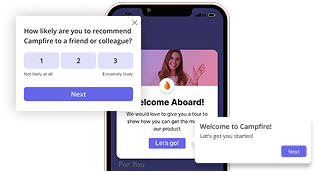
What is Gainsight PX?
Gainsight PX is part of Gainsight’s broader customer success ecosystem. It combines product analytics with in-app engagement tools to help companies understand how users interact with their product and to guide users through their journey.
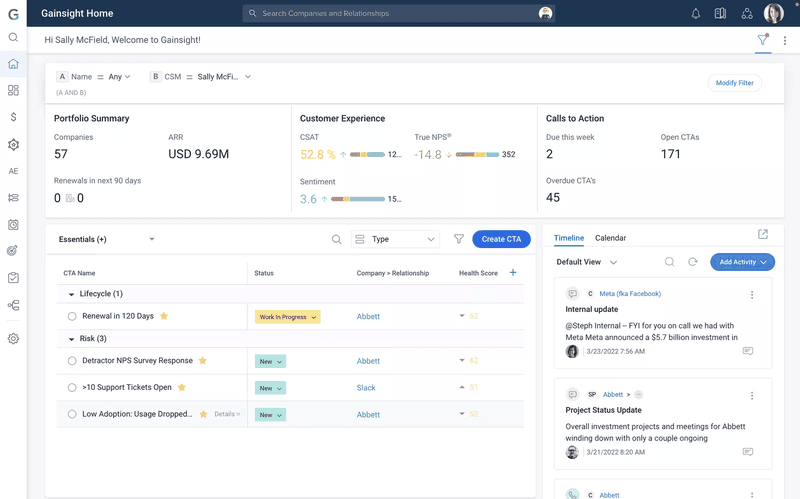
Essentially, Gainsight positions PX as the tool that connects product data to customer success outcomes. PX is targeted at mid-market to enterprise companies, particularly those with dedicated customer success teams. It’s built for product managers, customer success managers, and growth teams who need both behavioral data and the ability to act on it through in-app experiences.
On G2, Gainsight PX holds a 4.4 out of 5-star rating (based on 240 reviews). Users praise its segmentation capabilities and analytics features, but reviews frequently mention complexity as a trade-off. As one G2 reviewer notes:
Mapping the product has been EXTREMELEY challenging and required getting support from stakeholders that were not bought in.
Another common point from user feedback is the pricing. Gainsight PX is not transparent about pricing, and many users report that it’s costly for what it offers. One reviewer put it plainly:
Pricing seems to be expensive compared to other competing products…
From my perspective, Gainsight PX aims to be the all-in-one solution for enhancing product experience, bringing everything you need under one roof. However, in practice, its execution doesn’t always live up to that broad vision. For typical PLG teams, it’s powerful but not always as agile or easy to use as you’d hope.
What are the features and capabilities Gainsight PX provides for users?
Let’s dissect the primary features Gainsight PX offers and critically evaluate them through the lens of a product-led growth strategy.
Gainsight PX for product analytics
Gainsight PX analytics can work fine if you’re preparing quarterly business reviews or tracking high-level account health. But if you’re a product team trying to understand why users aren’t activating or which features drive retention, you’ll spend more time fighting the tool than getting answers.
When you first log in, the dashboards look impressive. You see adoption metrics, retention curves, feature usage breakdowns, and user cohorts neatly organized. But the moment you try to investigate why end users behave a certain way, you hit walls.
- Product mapping creates a maintenance bottleneck: Gainsight PX requires you to define your product’s features, modules, and ideal user paths via a Product Mapper. Then, the platform uses this structure to track journeys and recommend interactions. However, every time you ship a new feature, tweak a user flow, or redesign part of your interface, you need to manually update the product map. For teams shipping weekly or even daily, this quickly becomes a full-time job. Instead of adapting to your product’s evolution, the tool forces you to constantly maintain a parallel representation of it.
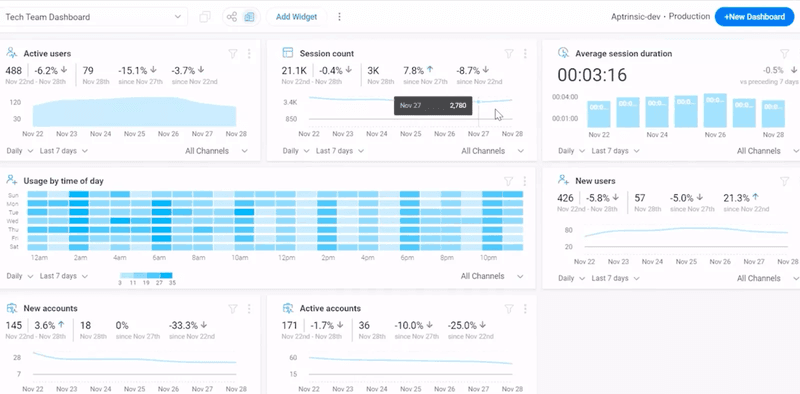
- Reports are built for presentations: Gainsight PX includes funnels, path analysis, and usage charts, but they show what happened, not help you figure out why. You can’t click a funnel stage to view the users who dropped off. You can’t click a usage spike to see which cohort drove it. Every question requires manual work to answer.
- Built for accounts: Here’s where the CS-first design becomes obvious. Gainsight PX excels at aggregating product usage across accounts and correlating those metrics with customer health scores. That’s useful if you’re managing enterprise accounts with multiple seats. However, the tool falls short if you need to understand individual user activation, engagement patterns, or feature adoption at a granular level.
Gainsight PX for product engagement
You can create user onboarding flows and announcements, but you’ll spend more time configuring, testing, and maintaining them than actually improving user experience.
- The engagement builder feels outdated: PX’s in-app flows, also known as “Engagements,” offer several patterns (such as dialogs and tooltips). But creating them feels rigid. The builder uses a flowchart-style interface where you manually piece together steps. The workflow isn’t intuitive, making the process time-consuming. Compare this to modern no-code builders, and Gainsight PX feels outdated.

- Customization stops at the surface: You can easily adjust text, colors, and button labels. However, when you need to add branching logic, personalize content based on user behavior, or create conditional paths, you’re either resorting to manual workarounds or accepting that the tool can’t handle it.
- Targeting depends on pre-built infrastructure: To show the right message to the right user, you need user and account attributes already synced from your CRM or customer data platform. Behavioral targeting exists, but setting up conditions feels clunky.
- Testing and QA aren’t always smooth: Before publishing an in-app guide, you’d expect an easy way to preview it, test different scenarios, and iterate. Gainsight PX makes this more difficult than it needs to be. Previews don’t always render consistently, and switching between editing mode, testing mode, and publishing requires extra steps.
- Updating live engagements creates friction: Once an engagement is live, making changes isn’t as simple as editing and saving. You need to republish flows, which can disrupt user experience. When you examine performance analytics, you’ll see completion rates and views. However, gaining deeper insights, such as why users drop off at a specific step, requires digging into separate reports or tools.
- Knowledge centers with stiff execution: Gainsight PX offers knowledge centers where you can create help articles or link to your existing knowledge base. There’s even a collapsible bot that suggests relevant content based on user actions. The limitation is that it’s challenging to customize the experience or dynamically serve content based on behavior.
Gainsight PX for customer feedback
Here’s where things get complicated: Gainsight’s real strength in user feedback lies in its separate Customer Success suite (Gainsight CS), not in PX itself. Accessing that power means committing to a much larger and more complex platform.

- Customer health scores: You can build sophisticated scoring models that combine product usage, survey responses, and account-level data to create a comprehensive view of customer health. This feature enables customer success teams to identify at-risk accounts early and intervene before churn occurs.
- Playbooks and workflows: Create standardized playbooks that automate repetitive tasks, like reaching out to detractors after a low NPS score or re-engaging users who’ve gone inactive. This ensures consistency across your CS team.
- 360-degree account view: The CS product aggregates data from across the customer journey (email campaigns, support, product usage, survey results, etc.) into one dashboard. PX data can feed into it, but PX’s own interface is more focused on product usage and in-app engagement, rather than things like contract renewals or support history.
- Surveys and feedback: Gainsight offers robust survey functionality with flexible distribution options, including surveys and reporting that directly tie to customer health metrics. PX’s in-app surveys are helpful for quick pulse checks, but they aren’t as deeply integrated into workflows.
Gainsight’s feedback tools are built for large-scale customer success operations, not for agile product teams trying to iterate based on user input. You might be paying for capabilities you don’t need.
Gainsight PX for omnichannel customer experience
For product-led teams that need to quickly launch coordinated campaigns across web, mobile, and email, the platform’s disconnected approach creates more work than it saves.
Gainsight PX claims to have “native omnichannel engagement features” that enable you to reach users across multiple touchpoints. It does support in-app messages, email campaigns, and mobile app engagements. And this may sound like a unified omnichannel solution, but in practice, it’s more fragmented than you might expect.
You can create five types of engagements with Gainsight PX: dialogs, sliders, guides, emails, and surveys. The in-app patterns (dialogs, guides, tooltips) work on web applications, while mobile engagements are limited to dialogs, sliders, NPS, CES, and rating surveys. You can schedule email campaigns based on user attributes, such as product usage or survey responses, but these operate separately from in-app flows.
My issue is that each channel operates in its silo. You can’t easily build a cohesive journey that:
- Starts with an in-app message.
- Follows up with an email if the user doesn’t engage.
- Continues on mobile.
Email engagements are time-based only and cannot be triggered by events like button clicks or page visits. This means you’re manually coordinating campaigns across channels rather than orchestrating a unified customer experience.
The most significant limitation is that Gainsight PX doesn’t offer real journey orchestration. You’re creating individual engagements per channel, not designing connected experiences that adapt based on how users interact across touchpoints.
Want to show an in-app tooltip, send a follow-up email if they dismiss it, and trigger a mobile push notification the next time they log in? You’ll need to piece that together manually or rely on external automation tools.
What are Gainsight PX pricing plans?
Gainsight PX makes sense if you’re an enterprise with a dedicated customer success function, big budgets, and the operational bandwidth to manage a complex platform ecosystem.
Gainsight PX doesn’t publish transparent pricing on its website. You’ll need to contact sales for a custom quote, which is already a red flag for teams that value clarity and predictability in their budget planning. But thanks to data from Vendr, a SaaS negotiation platform, we can piece together what you’re actually looking at.
According to Vendr (from 279 purchases), the median buyer pays around $50-51k per year for Gainsight products (which includes PX). Smaller contracts typically start at $13-14k, while large enterprise deals can reach almost $200k annually.
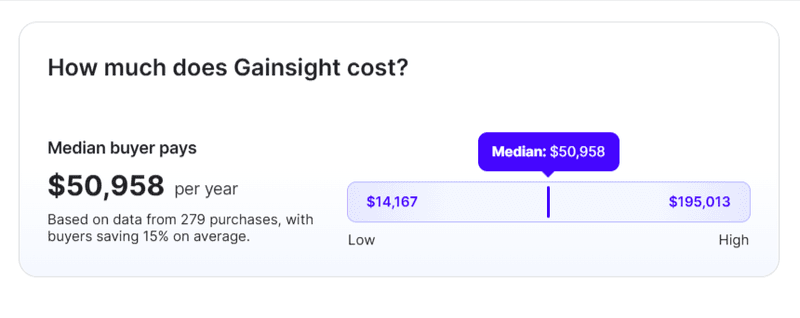
Gainsight also offers a free trial, which lets you test the platform before committing. But once you’re past the trial phase, the costs climb quickly.
Gainsight doesn’t just sell PX, it sells an entire ecosystem of products, including:
- Gainsight CS (Customer Success): A comprehensive suite for customer success teams, including health scoring, playbooks, account management, renewal tracking, and customer journey orchestration.
- Add-ons and integrations: You can purchase Staircase AI as an add-on for advanced AI-powered insights. Additional costs may apply for data synchronization, advanced integrations, and enterprise features.
For product-led growth companies, especially those with leaner teams focused on rapid iteration, Gainsight’s pricing structure is overkill. You’re:
- Paying enterprise rates for capabilities you may not need.
- Dealing with scattered costs across multiple products.
- Investing significant resources just to keep the system running.
Pros of Gainsight PX
Gainsight PX does offer some valuable capabilities that make it appealing for specific use cases. Here are three strengths that I consistently saw in user reviews:
- Robust segmentation capabilities: Gainsight PX offers powerful segmentation features that enable teams to target specific customers with tailored messages. You can create custom segments based on user behavior, demographics, and other criteria.
- Comprehensive feedback collection: Within PX (and even more so if integrated with Gainsight CS), you can collect user feedback in multiple ways. PX supports launching NPS surveys in-app, as well as CES (customer effort) and CSAT-style rating surveys.
- Integration with Gainsight CS for enterprise customer success: For companies that use Gainsight’s broader suite, PX integrates seamlessly with CS. This means product usage data collected by PX can be piped into customer health scores, renewal dashboards, or trigger “calls-to-action” for account managers.
These strengths are real, but they come with an important caveat: they’re most valuable for enterprises with the resources to fully implement and maintain the platform. For smaller, more agile teams, the operational overhead required to leverage these capabilities often outweighs their benefits.
Cons of Gainsight PX
Here are the most critical limitations based on user feedback and our research:
- Steep pricing creates a barrier to entry: Gainsight PX’s pricing model is a significant deterrent for most PLG teams. The median $50k+/year price puts it out of reach for many startups and smaller businesses. Especially when more agile, cost-effective alternatives deliver similar or better value for product adoption and engagement.
- Operational complexity requires dedicated resources: Implementing and maintaining Gainsight PX can quickly become a full-time job. The platform often requires a dedicated technical team for setup, ongoing optimization, and integration with your product. One user experienced this firsthand:
During the implementation of Gainsight PX we found it has a steep learning curve. Mapping our product within the platform was challenging, less intuitive than previous apps, and required significant time and effort.
- Delayed time-to-value frustrates teams: Despite its capabilities, Gainsight PX lacks true intuitiveness. Product managers, growth marketers, and customer success specialists all need to invest considerable time learning both basic functions and advanced features. Another user shared their struggle:
Implementation phase has taken too long for most of functionalities. We are reporting on feature level and not reporting to higher levels as we still dont have valuable attribute combinations. Some attributes function wiered when imported and are not usable.
- Functionality gaps limit flexibility: While Gainsight PX includes engagement features, its onboarding and in-app guidance capabilities feel less extensive and flexible compared to platforms built specifically for digital adoption. You can create guides, but they tend to be rigid and less interactive than what dedicated product experience platforms offer. As one G2 reviewer puts it:
the reporting features within PX are a little less intuitive than I would prefer, requiring more work…
The platform looks polished on the surface, but it lacks the interactivity needed to track user behavior effectively and deliver fast, actionable insights for improving feature adoption.
If you’d rather avoid these limitations, some alternatives offer better agility, faster time to value, and more reasonable pricing.
Why Userpilot is the best alternative for Gainsight PX
Userpilot stands out as the optimal choice for product-led growth teams. We designed our platform to solve the exact problems you just read about: high costs, operational complexity, delayed time to value, and rigid functionality.
Product managers, growth marketers, and customer success teams use Userpilot to drive adoption, boost engagement, and improve retention. Without the technical overhead or enterprise price tag.
Additionally, we’re introducing AI-powered features to help you leverage product intelligence and accelerate business growth. Join the waitlist for early access.
Here’s why Userpilot delivers better value for PLG teams like yours:
- Unified platform with omnichannel experience: Unlike Gainsight, Userpiot gives you everything in one place: product analytics, in-app engagement, surveys, and omnichannel experience. It’s straightforward, so you can track product health, identify user friction, and launch targeted interventions without switching tools or managing multiple contracts.
- True no-code builder: Our visual build requires zero coding. So anyone on your team can create meaningful user experiences without help from engineering. You can click any UI element, and Userpilot automatically detects the best CSS selector. Build interactive walkthroughs, contextual tooltips, and onboarding checklists in minutes, not weeks. Plus, our AI assistant generates and refines text for tooltips, modals, and banners instantly. Use it to write clear, consistent messaging faster than ever.
- Actionable analytics: Userpilot doesn’t dump static dashboards on you. Our interactive analytics help you understand what’s happening and why. You can effortlessly visualize user journeys with path and funnel analysis. Track feature adoption in real-time. Monitor retention from centralized dashboards. Every insight is clickable, explorable, and actionable, enabling you to iterate quickly based on actual behavior, not guesswork.
- Versatile engagement features: Our in-app engagement toolkit is both extensive and exceptionally flexible. Access a wide array of UI patterns, including interactive walkthroughs, onboarding checklists, knowledge bases, and resource centers, to enhance your user experience. All you need to improve user engagement. Whether you want to implement in-app guidance, provide self-service support, or announce feature updates. And unlike Gainsight PX, Userpilot supports true omnichannel out of the box: you can engage users on web and mobile, and even send follow-up emails triggered by in-app events. In short, you can reach the user with the right message at the right time on the right channel, without having to cobble together separate systems.
- A practical toolkit to turn insights into action: Understanding user sentiment is crucial for a successful PLG strategy, and it’s easy to do using our toolkit. With Userpilot, you can launch NPS, CSAT, and CES surveys in-app at the right moment. Configure follow-up questions based on responses to gather more insights.
- Integrations that connect your entire stack: Userpilot integrates natively with the tools you already use: HubSpot, Salesforce, Segment, Amplitude, Google Analytics, Mixpanel, and more. Sync user properties and events to trigger automated campaigns. Enrich your CRM with product usage data. Create personalized experiences throughout the customer journey, all without custom development.

Userpilot pricing
Userpilot offers transparent pricing with no hidden costs or surprise uplifts. You get fair, predictable contracts and full migration support if you’re switching from Gainsight.
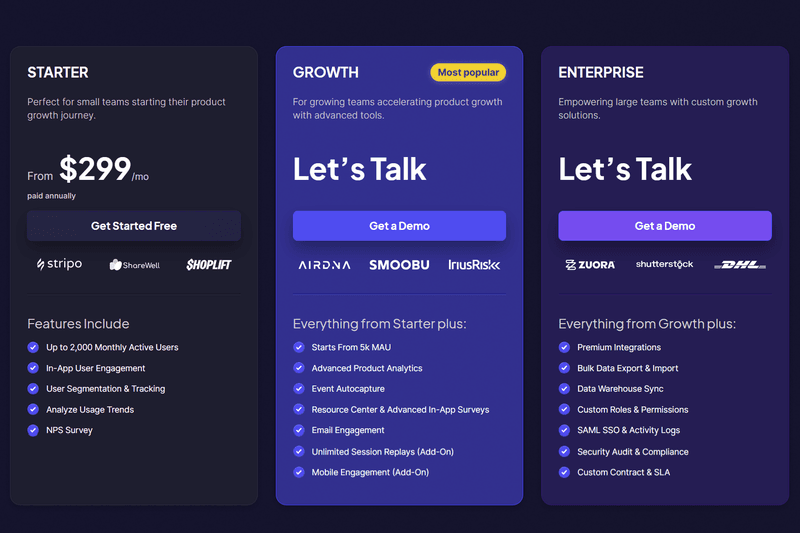
Our plans include:
- Starter: $299/month (billed annually) for up to 2,000 monthly active users. You have access to in-app engagement, user segmentation, usage trends, and NPS surveys.
- Growth: Custom pricing for growing teams. Gain additional features such as product analytics, event autocapture, in-app surveys, resource centers, and mobile support.
- Enterprise: Custom pricing for large teams. Includes premium integrations, bulk data export/import, SAML SSO, and enterprise-grade security.
All plans include a 14-day free trial, with no credit card required. They have flat, MAU-based pricing (no per-seat fees), which scales with your growth. This contrasts with Gainsight, which often layers costs for different modules or limits the number of seats.
Ultimately, the choice comes down to what you need for driving product growth. Gainsight PX is powerful, but in its attempt to be all things to all people, it has become heavy and complex. Userpilot focuses on the core of PLG (understanding user behavior and improving it through in-app experiences) and does it in a way that’s accessible to teams of any size.
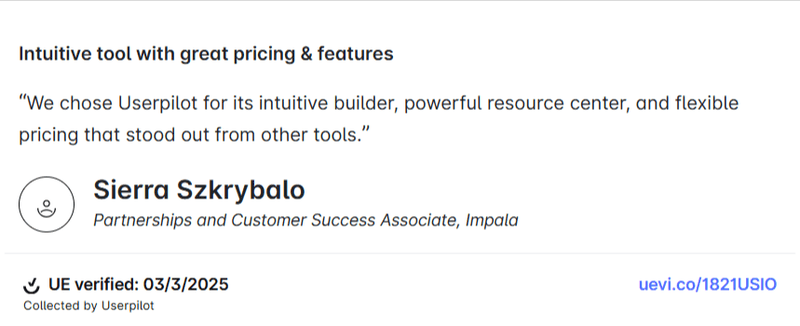
Ready to see the difference? Book a demo and experience how Userpilot makes product growth faster, simpler, and more affordable than Gainsight PX.
DISCLAIMER: Userpilot strives to provide accurate information to help businesses determine the best solution for their particular needs. Due to the dynamic nature of the industry, the features offered by Userpilot and others often change over time. The statements made in this article are accurate to the best of Userpilot’s knowledge as of its publication/most recent update on November 10, 2025.

